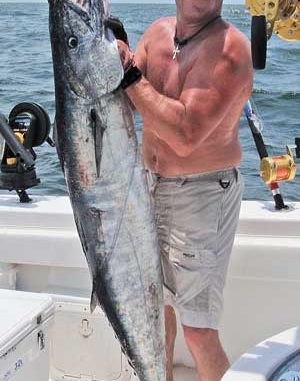
Area biologists give their picks for the top public areas for deer, squirrel, rabbits and more this season.
Sleek, fast and glamorous, wahoo are the Formula One race cars of the fish world. Scientists know them as Acanthocybium solandri. The genus name is derived from the Greek words for “thorn” and “a tunna,” so it is essentially described as a “thorny tuna.” Although they may not look like it, wahoo are indeed members of the tuna family, as are not-so-tuna-looking cero, king mackerel and Spanish mackerel. Other members of the family are bluefin tuna, yellowfin tuna, blackfin tuna, bigeye tuna, skipjack tuna, albacore, chub mackerel, frigate mackerel, bullet mackerel, Atlantic bonito and little tunny.
Albacore and frigate mackerel are uncommon in the Gulf of Mexico, and Atlantic bonito are rare. Louisiana anglers make up for the rarity of Atlantic bonito by regularly tagging little tunny with the name “bonito” or “bonita.”
Wahoo are beautiful, especially when first caught. The back is an iridescent blue-green, shading to silver on the sides. Vertical wavy blue bars adorn its sides. As with many other pelagic fishes, body colors fade rapidly after the fish dies.
Although they may resemble king and Spanish mackerel in body shape, they are relatively easy to tell apart from their kin. Aside from their unique color pattern, the upper jaw of a wahoo has a fold of skin that partially covers the lower jaw, giving the head an almost duck-bill like appearance.
The head is also very pointy and beak-like, more so than with mackerels. Shortly after hatching from the egg, young wahoo have such a pronounced beak that some biologists have suggested that wahoo may belong in the billfish family rather than with tunas.
Wahoo are an odd fish. In a family of fishes that prefer to school, they are either solitary or hunt in small packs. They seem to be found everywhere in tropical and subtropical waters; they are not rare, but nowhere are they abundant.
Their range encompasses the whole of the Indian Ocean and the Mediterranean Sea, all the waters off of Southeast Asia, Africa, Australia, most of South American waters and North American waters to southern California in the Pacific Ocean and North Carolina in the Atlantic Ocean.
Because of their scattered nature, a focused commercial fishery has never developed for the fish in the United States. Wahoo catches in the recreational fishery are usually made incidental to fishing for other species, typically billfish, dolphin, king mackerel and tuna.
Most recreational catches are made by trolling, and most of the small commercial catch is made with longlines set for other species. No matter when or how it is taken, the wahoo is a prized catch.
Unlike many members of the tuna family, the flesh of the wahoo is very white in color. It is mild in taste and makes superb sashimi or sushi. Its only defect is that it will very quickly dry out and turn to sawdust if overcooked. Frying is not the best option for preparing this great table fish.
Wahoo are fish predators, with over 90 percent of their diet being made up of finfish and the remainder being mostly squid. Finfish commonly found in their diet include other members of the tuna family such as mackerels, little tunny and small tuna. Other fish found in their stomachs include dolphin, jacks, flying fish, herrings, porcupine fish and puffers; however, the most important fish in their diet are other members of the tuna family.
Everything about wahoo is fast. Their swimming speed is torrid, probably only exceeded by that of sailfish. In bursts, they can swim 50 mph. They also have great swimming endurance. Precious little can escape them by out swimming them.
They grow as fast as they swim. In the Gulf of Mexico, male wahoo will grow to 37 inches long and be sexually mature in one year. Females grow just as quickly and average maturing at 1.3 years old. One tagged wahoo grew from 11 pounds to 30 pounds in one year. Their growth rate does not seem to slow down much as they get older. Wahoo over 40 inches long average growing 1.2 to 1.5 inches per month, not as fast as dolphin, but still respectable.
Their estimated life span is 9 years, and is similar for both males and females. Wahoo of 180 pounds have been recorded.
They spawn like they live — prodigiously. During the four months from May to August, wahoo will spawn an average of once every five days. Each spawn will result in 440,000 to 1.67 million eggs being laid, with larger fish producing more eggs per spawn. Averaging large and small fish together, females will produce 60 million eggs per year.
Wahoo live fast and die young. They are an angler’s treat, whether ripping line off a reel after a strike or as luscious steaks hot off the grill.


